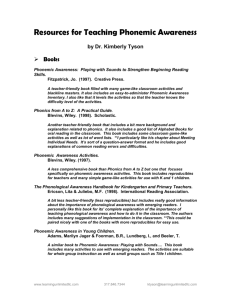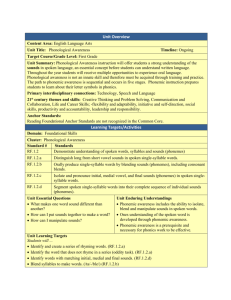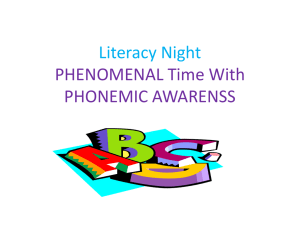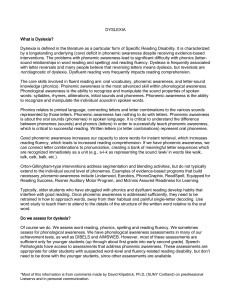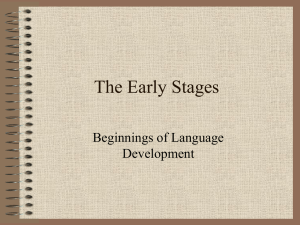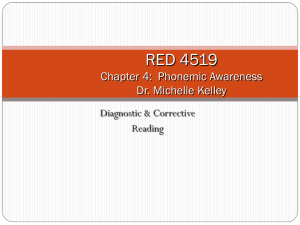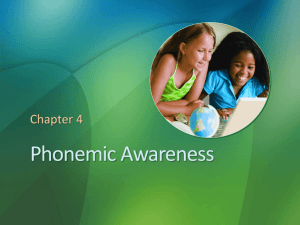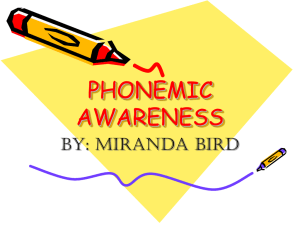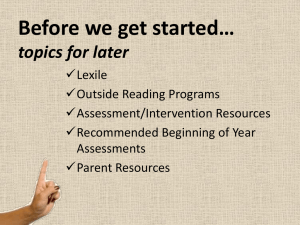Phonological or Phonemic Awareness
advertisement
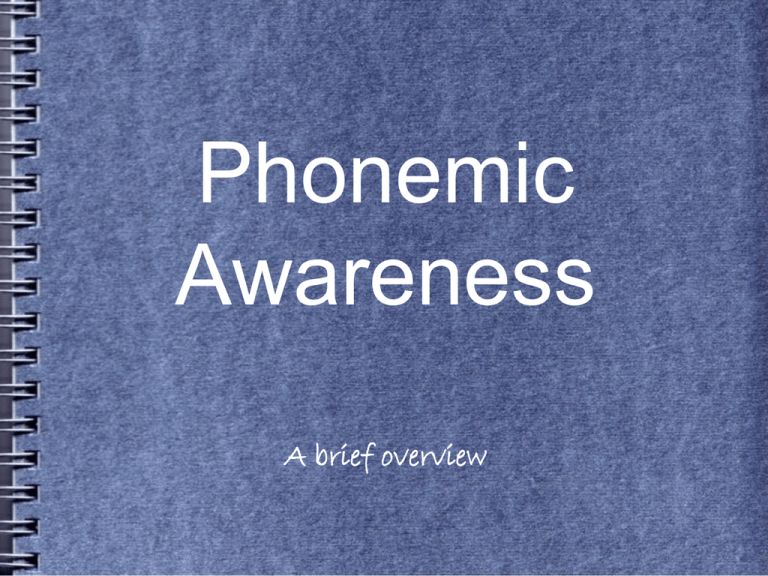
Phonemic Awareness A brief overview Phonemic Awareness is vital to language, vocabulary, listening comprehension, spelling, writing, and word recognition. Phonemic Awareness is the ability to identify and recall individual sounds in words. hat /h/ /a/ /t/ cat /c/ /a/ /t/ Children sometimes do not perceive or distinguish sounds accurately …..and that makes it really hard to read hat cat /h/ /at/ /c/ /at/ Why ? Some research shows a delay among the areas of the brain that control auditory perception. This makes it difficult for children to identify and associate the correct sounds. Sometimes children have not heard clear speech at home. Huh ? Wudyasay ? Phonological or Phonemic Awareness ? Both focus on the SOUNDS in spoken words. Phonics is connecting the letters with sounds (visual). Phonological Awareness Broad term - includes phonemic awareness alliteration, rhyme, words, and syllables Distinguish words within a sentence Phonemic Awareness Narrower, subcategory of phonological awareness. Phonemes – sounds within words /w/ /i/ /sh/ - 3 sounds Identifying Phonemic and Phonological Awareness Issues ● Jumbled words ● “I push my hair.” “I brush my hair.” ● Inability to attend to rhyme ● Missing or incorrect sounds in words ● Substituting one sound for another – /k/ for /g/ ride in a wakon ● Difficulty following spoken directions ● Unwillingness to participate in class Identifying Phonemic Issues ● Teacher Observation ● DIBLES ● Phonological Awareness Profile (PAP) ● ● ( screening only ) designed to provide information for instruction Diagnostic Testing How Teachers Can Help ● Identify problems early – ● Kindergarten or 1st Grade – ● ● and provide systematic instruction with older children Explicit Instruction in Phonemic Awareness ● Encourage self-awareness of sounds ● Activities, Games, Raz-kids.com ● Multisensory Continuing Evaluation ● assess progress and identify specific needs Skills for Phonemic Awareness ● Discriminate individual words in a sentence ● Identify syllables within words ● Rhyme words ● Identify phoneme position (beginning, middle, end) ● Blend sounds ● Segment sounds ● Accurate recall of sounds Teacher Tools Mirror Whisper Phone Rubber Band Elkonin Technique Short Vowel objects Whole Class Activities to Teach Phonemic Awareness Stretchy Names ● ● K – 1 - Whole Class or small group Children and teacher clap and say a verse for each child in class: ● CHRISTOPHER, CHRISTOPHER, HOW DO YOU DO ? ● ● WHO IS THAT FRIEND RIGHT NEXT TO YOU ? Children and teacher say the next child's name very slowly, stretching palms far apart as the word is stretched: krrrr-/iiiiiii-/ssssss-/tuuuu-/ffffff-/errrrrr/ Whole Class Activities to Teach Phonemic Awareness ● Jump Along with Phonemes ● ● ● K – 2 Whole Class or small group Place 12 lines on the floor with painter's tape. The teacher calls out a word, and students jump once for each sound in the word. Use for new vocabulary words from Reading, Science, and Social Studies Instruction for Older Students Older students who struggle may need individual instruction. – Lesson Template ● Select words from current spelling lesson, Social Studies vocabulary, Math terms, or high utility words. Time No more than 20 hours per year or about 7 minutes per day. For more information about Phonemic and Phonological Awareness visit http://lincs.ed.gov/readingprofiles Thank you !
